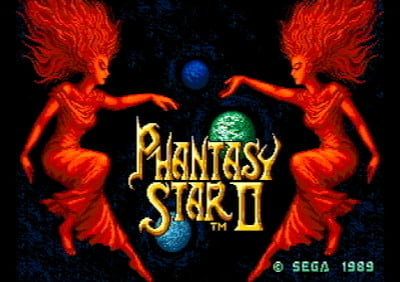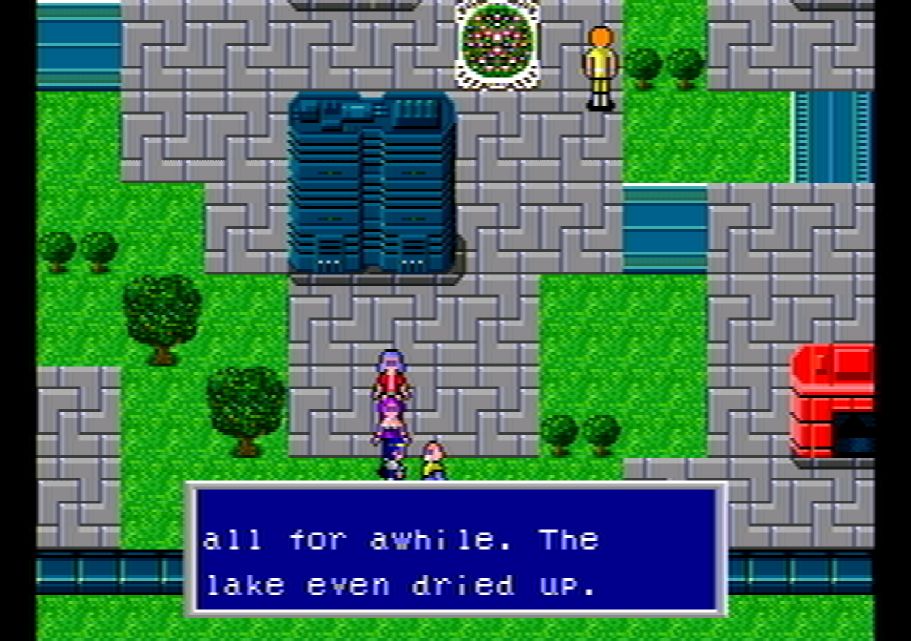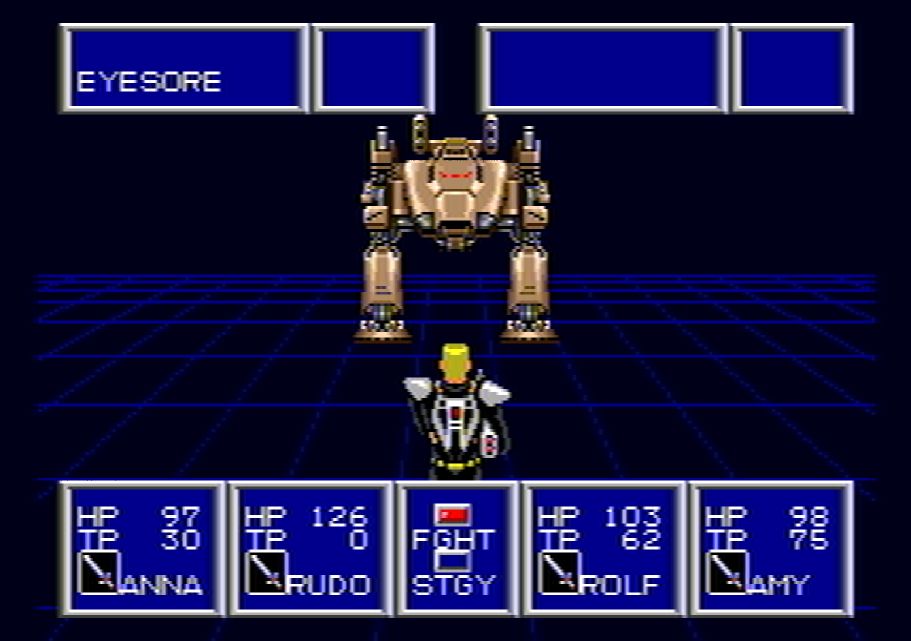
Phantasy Star II (Sega Genesis) Review
~by tankMage (May 2025)
Score: 8/10 (Good)
A fascinating piece of RPG history.
Phantasy Star II is one of the most interesting RPGs I have ever played, both from a historical prospective and for its inherent entertainment value. Having been made in 1989, this is one of the earliest 16-Bit RPGs…if not THE earliest role playing game of its kind. As such, there’s a lot aspects of its design that are hold-overs from the 8-Bit era. While PS2 lacks quality of life features that gamers in the 90s would have expected (let alone modern players) it makes up for its failings with impressive graphics (by 1989 standards) and brilliantly designed dungeons. Be forewarned: this RPG is not forgiving in the least and requires dedication to complete.

Back to the future’s future!
Phantasy Star II takes place a thousand years after the first game. In the interim, a super computer called Mother Brain (not to be confused with a certain other Mother Brain) took control of the planets in the Algo system, turning the three worlds into paradises. The governor of Mota calls upon an agent named Rolf to investigate the sudden appearance of monsters on Mota, which Mother Brain should not allow.
Rolf takes his girlfriend (a cat girl he found on the street…seriously) and begins his journey. In true video game fashion, no investigation is simple, and Rolf soon learns of an evil plot. I don’t want to spoil the story, but the game takes some surprising twists and turns as Rolf gets deeper into the plot.
While the premise is original and entertaining, PS2 suffers from the usual translation woes one would expect from an old JRPG. As far as I know, Sega did not censor the script, but space limitations and the usual difficulties that come with translating Japanese to English plague this game. There are also a few plot points that do not quite make sense to me, but it’s hard to say if this was due to limitations or just stupidity on my part. For the most part, the story is entertaining and rewarding enough to make PS2 stand out among RPGs.
Gorgeous Graphics?
The Sega Genesis was cutting edge back in 1989 and I’m sure the map and character designs blew players away, especially for a genre that often got the sort end of the stick when it came to visuals. That said, it looks more like an upgraded 8-Bit RPG rather than a proper 16-Bit game. However, I don’t think this is a bad thing. If anything, the squat buildings, low detail dungeons, and simple map sprites give this title personality.
While some of the graphics may have been transitional in nature, the artwork for character portraits and monsters is superb. Every major character, from Rolf to the shopkeepers, has a cool looking anime style portrait. Playable characters also have detailed sprites for combat, complete with animations… which is more than I can say for Phantasy Star III, but that’s a topic for another review.*
The various monsters and machines that attack Rolf and his friends are also beautifully drawn and animated. It’s been a long time since I’ve seen such creativity and work put into RPG enemies, which is a nice change of pace.
*I forgot to mention some of the playable characters are pallette swaps, which is kind of lame, but there’s eight playable characters, so it’s cool.

Talk about old school…
If I had to name a game that embodied the spirit of 1980s JRPG design, I would choose Phantasy Star II. Everything about this game oozes with the merciless design philosophy of its time. It takes hours of grinding to get strong enough to survive dungeons. Heck, just finding the dungeons can be difficult. Once you actually get inside a dungeon you’ll have to contend with complex mazes of corridors and staircases as well as tough enemies.
I rarely die in RPGs, but this game curb stomped my party several times. Party members even died while I was grinding, which is basically unheard of to me. So it’s a necessity to always pay attention in combat.
It’s also vital to carefully gather information and clues to puzzles. While I hated to have to do it, I had to check a guide many times to figure out how to get through the dungeons or what I needed next. I can imagine players getting stuck for hours in the old days, before the internet.
Players will start with just Rolf and his waifu, Nei, then recruit more characters as they explore until their are eight party members. Only four people can be in the party at once and everyone has their own talents, so you’ll want to think carefully about who you take along. For example, one character is good at fighting living things, while another is adept at destroying robots. Other characters are generalists who are safe choices throughout the game.
Characters are limited to attacking, defending, using items, and casting spells, which is pretty normal for an RPG. The spells are called Techs, but they are basically what one would expect: fireballs, shields, healing spells, and just about anything else a player could need or want.
As much as I like this game, the amount of grinding required to level up is staggering. It often took more time to grind to prepare for a dungeon than it did to explore it. If you want an idea of how much players have to grind, enemies at the end of the game give about 3k to 4k exp per battle, at about level 40, characters start needing 300k experience to level up, so it’s going to take about a hundred battles to get from level 40 to 41. It only gets worse from there. On top of that, fighting is never easy. Even with all the best gear and high levels, my party could not defeat monsters in less than two turns in most cases. On top of that, I had to frequently stop to heal which was time consuming.
There are few bosses in this game, but the ones that exist are tough as nails. I really appreciated this aspect of Phantasy Star II, because every boss fight was climactic. One boss in particular wiped out my party several times, which is something that hasn’t happened to me in years. So, if you’re a hard core RPG fan, you’ll probably enjoy this game.
Overall, this PS2 didn’t bring anything new to the table even in 1989. But it does offer a highly refined (and unforgiving) incarnation of the classic 8-Bit RPG formula.
Genesis Twang
The Sega Genesis has a very distinctive sound and I’m always happy to play games that manage to utilize it effectively. One could argue Phantasy Star was practically made for the Genesis sound chip or vice versa, because the tones it produces fit the mood of the game perfectly. I can’t think of a single track I didn’t like and the dungeon melodies are some of the best I’ve heard. I just wish they included an alternate battle theme, because I was sick of hearing it after grinding for 30 hours.
On the other hand, the sound effects can get quite annoying. In particular, the effect that plays when a party member takes damage really got on my nerves after hearing it thousands of times. In fact, I had to turn the volume down while grinding after a while because the sound effects were so bad. At the time they must have been a huge step up from the Sega Master System, but human nature doesn’t change and I imagine I would have found it irritating back in 1989 despite its novelty.
Cumbersome Controls
Oh boy, the User Interface for this game is something else. In some ways, the devs were ahead of their time, but in other ways the UI is absolutely horrible.
So I’ll start with what this game does well, which happens to be how it handles battle commands. When in combat, your party members have preset commands, which they will execute when you choose the fight command. They will execute these commands until there is a major change in their status or if they use certain items and spells. In such cases the game will prompt the player to issue the Fight command again or input specific orders.
For example, Rolf uses a weapon attack by default, but the player can tell him to use medicine. Once Rolf uses the medicine, the game will ask the player to issue a new command on the next turn. If the player merely orders Rolf to attack, he’ll keep attacking until the player cancels the command or the battle ends.
This system eliminates a lot of the repetitive button pushing that is so common to RPGs and it’s great. Too bad they didn’t keep this mindset when developing the other UI systems.
Another great feature is a semi-secret item that let’s you save anywhere in the game. I can’t overstate how useful this is in a game that is as difficult as this one. It takes a while to get this item, if you find it at all, but it’s great once you have it.
I also liked how every town had a teleport station, which allows the player to move around the map easily. But the teleport system does not work everywhere and the game forces players to backtrack through certain areas should they choose to leave, which really sucks.
If you want to use a spell or item outside of battle, you’ll have to go into the command menu, which is fine until you come to the point where you have to use a spell or item more than once. If you want to cast a healing spell two or three times or use two or three healing items (which you’ll have to do quite often) you’ll find that the command menu closes after you use the item or cast the spell. Consequently, you’re going to have to reopen the command menu, choose a character, choose a spell/item, then choose who to apply it to EVERY freaking time you need to heal… and you gotta heal a lot in this game. Fiddling around with the menus in this fashion gets tedious very quickly.
Inventory management is also a nightmare. There’s no easy way to shuffle items around and the game just dumps everything a character picks up or buys in his or her inventory in the order that they found the item. So you’re either going to have to go to the storage room and shuffle items around by putting them into storage and taking them out in the order you want or you’re forced cycle through inventories on search of the item you want to use.
Worse yet, everyone has his own inventory, which has limited space, so you’re going to have to comb through or manage up to four inventories at the very least. If you use more than four of the playable characters you’re going to have to fiddle with up to eight inventories. Have fun with that.
I spent a lot of time ranting about how bad the UI is, but I’ve probably left something out. It’s a shame, because PS2 would have been a more enjoyable experience had they cleaned the UI up a bit. That said, I think this game is still worth playing on its virtues, you just have to endure the awful menu system.
Final Thoughts
Well, it’s a cool game and in spite of all of its problems, I think Phantasy Star II has a place in the classic RPG cannon, which is a pompous way of saying you should try this game if you like old RPGs. It’s tough, the story is crazy, and the graphics are unique, which is enough to make it stand out in a world of clones and copycats. Just make sure you approach this title knowing it’s going to be difficult to work with and you won’t get too frustrated with it…hopefully.
RetroMaggedon.com ©2025
